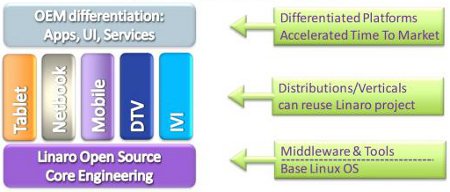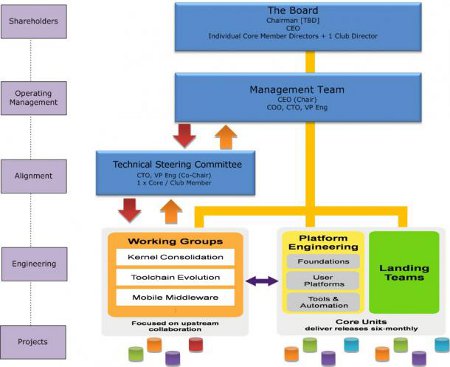ARM SoC vendors launch non-profit for embedded Linux software
Jun 3, 2010 — by Eric Brown — from the LinuxDevices Archive — 5 viewsARM Holdings and five semiconductor manufacturers have formed a not-for-profit engineering firm to develop standardized, open source Linux tools, kernel, and middleware software for consumer electronics. “Linaro” is jointly owned by ARM, Freescale, IBM, Samsung, ST-Ericsson, and Texas Instruments, and will initially support ARM Cortex-A tools on distros including Android, LiMo, MeeGo, Ubuntu, and WebOS.
Linaro says it is open to supporting any processor architecture with standardized open source Linux tools. Yet, as the testimonials farther below indicate, ARM — and specifically ARM Cortex architectures — is the major focus. Standardized code and tools aligned for ARM Cortex-A based system-on-chips (SoCs) will be released in November, with subsequent releases following every six months, the firm says.
Optimized Linaro tools, kernel, and middleware software, including low-level power management and boot process software directly related to the Linux kernel will be validated for a wide range of SoCs, the company adds.
In addition to developing open source tools, Linaro will contribute code and invest resources in open source projects to ease development using the increasingly complex SoCs used in consumer electronics (CE) devices. Chief goals are said to include reducing power consumption, as well as improving boot time. Targeted products include smartphones, tablets, digital televisions, automotive entertainment, and enterprise equipment, says Linaro.
Linaro's contributions will allow device manufacturers to speed development time, improve performance, and reduce engineering time spent on non-differentiating, low-level software, says the company. Meanwhile, Linux distributions, as well as open source and proprietary software projects, are said to benefit from access to more stable, standardized code.

Linaro conceptual diagram
Based in the U.K., Linaro already hosts 20 engineers, and will soon ramp up to over 100, according to a IDG News Service story by Dan Nystedt, who covered the announcement in Taipei, Taiwan, held in conjunction with the Computex show.
Tom Lantzsch, interim CEO of Linaro and an EVP at ARM Holdings, said that the Core members have pledged to fund the Linaro with "tens of millions of dollars" per year, says the story. Nystedt also reports that one early project is to develop fast boot kernel technology that could work across various mobile Linux distributions.
Validated code and Canonical's LaunchPad
Linaro is not an embedded Linux distribution, but rather a common software foundation and set of tools that can be freely used by other Linux distributions, says the company. Silicon suppliers will be able to test their board support packages (BSPs) against the validated code, which will also be available under open source license to device manufacturers, distributions, and software developers, says Linaro.
Linaro is open to new memberships, available in three tiers: Core memberships; Club memberships, which offer access to four working groups; and individual Communty memberships, which come with "simple contribution agreements," says the company. All code developed within Linaro working groups is said to be available under standard Open Source Initiative (OSI) license terms.

Linaro org chart
(Click to enlarge)
In addition, Linaro intends to work in partnership with the Linux Foundation to align on core operating principles, says the company. The Linux Foundation hosts the MeeGo operating system backed by Intel and Nokia, neither of which are Linaro members.
Linaro Core members and no-shows
All the partners — save IBM and ARM itself — develop SoCs based on Cortex-A cores, including both the widely deployed Cortex-A8 SoCs and more powerful, multicore focused Cortex-A9.
For example, Freescale offers its i.MX51 family of Cortex-A8 SoCs, and Texas Instruments provides its various OMAP3x Cortex-A8 SoCs, as well as the Cortex-A9-based OMAP4x. Last September, Samsung announced S5PC110 and S5PV210 Socs, both based on Cortex-A8 cores, and ST-Ericsson is working on a Cortex-A9 SoC that incorporates virtualization technology from OK Labs.
The two major no-shows on the list are Nvidia and Qualcomm. Nvidia's Tegra 2 is built on a dual-core Cortex-A9, while Qualcomm's Snapdragon is not technically a Cortex-A8 SoC, but is similarly based on the ARMv7 instruction set and offers similar superscalar technology.
Other vendors prepping Cortex-A SoCs include NEC Electronics, which announced a Cortex-A9 version of its EMMA Mobile series of multimedia SoCs called the EMMA Mobile/EV. NXP, meanwhile, offers a Cortex-A9 SoC family for set-top boxes called the PNX847x/8x/9x.
Analysis
Industry organizations like Linaro come and go all the time, with organizations such as the Open Mobile Alliance (OMA) playing modest background roles. True, an organization called Open Handset Alliance (OHA) has done pretty well for itself, though most Android phone owners have never heard of it, and the press tends to call the Linux-based operating system Google's Android instead of OHA's Android.
Other groups have not been quite so fortunate. The LiMo Foundation continues on, for example, but appears to be having trouble getting its members to meet their promised smartphone deployments in the face of competition led by Android. Previous mobile standards consortia such as The Linux Phone Standards (LiPS) Forum have faded altogether. (Most of the LiPS members joined LiMo back in June 2008.)
Then again, the formation of an actual company with engineers and substantial funding could give Linaro more clout, Strategically, Linaro can be seen as another front in the growing war between ARM and x86 for ownership of the CE universe. It can also be seen as a response to the acquisition by major chip vendors of the two major commercial embedded operating systems and toolsuite vendors.
Wind River is now owned by Intel, and MontaVista by Cavium, which is primarily invested in high-end MIPS networking SoCs, but also sells a line of Econa-branded ARM11 CE SoCs.
Linaro appears to build on ARM's earlier efforts such as the "ARM' Connected Community" announced last November along with its Solution Center for Android. Here again, the focus is on easing development for Cortex-A cores.
More practically, Linaro addresses a number of related problems facing the embedded Linux development community, especially in the mobile CE devices. First, the number of open source and quasi-open source Linux development projects for mobile devices is expanding, causing major headaches for both device and application developers.
Google and OHA have the clear lead with Android, but even there, fragmentation is a problem, and Chrome OS will complicate matters further. Meanwhile, mobile device firms and wireless carriers continue to push their own Linux-based distributions including HP/Palm (WebOS), Samsung (Bada), European carriers such as Vodafone (LiMo), and Nokia (Symbian 3 and MeeGo).
In addition to other various proprietary embedded Linux platforms used in CE, NTT DoCoMo and various Japanese CE firms recently announced they were developing a new Linux-compatible mobile OS. Then there are the desktop Linux distributions, most of which are spinning versions for netbooks. Ubuntu, for example, appears to be taking a pass on MeeGo in favor of its own Ubuntu Light netbook distro and underlying Unity desktop environment.
At the same time, the SoCs being incorporated in CE devices are growing increasingly complex. Multicore is a particular problems for developers, especially in optimizing devices for performance and battery life.
Both Wind River and MontaVista are attemping to address these issues in various ways. For example, the acquisition of Virtutech by Intel bring Wind River customers the multicore optimized Simics simulation platform. Meanwhile, the reorganization of MontaVista Linux into versions optimized for different SoC platforms was said to be caused in part by the growing complexity of multicore development and the growing body of code surrounding each SoC platform.
Testimonials
Stated Tom Lantzsch, executive officer, Linaro, "The dramatic growth of open source software development can now be seen in internet-based, always-connected mobile and consumer products. Linaro will help accelerate this trend further by increasing investment on key open source projects and providing industry alignment with the community."
Stated Warren East, ARM CEO, "As a founding member of Linaro, we are working together with the broader open source community to accelerate innovation for the next generation of computing."
Stated Lisa Su, SVP and GM of Freescale's Networking and Multimedia Group, "Linaro represents an important step forward in developing the ecosystem for these smart mobile devices through dramatically speeding and simplifying software development cycles and leveraging the power and strength of the open source community."
Stated Daniel Frye, VP, open systems development, IBM, "We are strong proponents of working with partners such as ARM to further our commitment, ensuring embedded Linux is the leading platform for innovation in the mobile and consumer electronics markets."
Stated Yiwan Wong, VP, System LSI marketing, Samsung Electronics, "We fully appreciate the significance of having an optimized Linux software foundation and tools for our ARM CPU core base products, to support our customers' needs with high quality solutions."
Stated Teppo Hemia, VP, 3G Multimedia Platforms Business Unit of ST-Ericsson, "Being an active contributor in the open source community, we are excited to be one of the founding members of Linaro and expect our combined efforts to accelerate the development of Linux-based devices."
Stated Remi El-Ouazzane, VP and GM, OMAP Platform Business Unit, TI, "Linaro is intently focused on delivering critical open source components to enable developers building on ARM-based processors. An important element of that delivery is a more complete, higher quality development toolset that increases performance."
Stated Jane Silber, CEO of Canonical, "By standardizing many of the core software components, companies can focus on creating great user experiences on embedded devices through to smart phones."
Stated Morgan Gillis, executive director of LiMo Foundation, "We welcome the launch of Linaro as a new industry organization with similar values and a complementary focus to LiMo Foundation."
Stated Jim Zemlin, executive director of The Linux Foundation, "The Linux Foundation is happy to see ARM and Linaro increase their investment in Linux."
Availability
Linaro's first release is planned for November, providing performance optimizations for SoCs based on the ARM Cortex-A processor family. More information on Linaro may be found at its website, here.
A Linaro Engineering Summit is scheduled for July 19-23, in Prague, Czech.
The IDG News Service story on the Linaro press conference may be found here.
This article was originally published on LinuxDevices.com and has been donated to the open source community by QuinStreet Inc. Please visit LinuxToday.com for up-to-date news and articles about Linux and open source.